How to Make Timesheets Easy for Employees
What Is a Timesheet?
A timesheet records the amount of time an employee works on tasks. Timesheets are a mechanism for payroll used by management, human resources and accounting to record time and pay employees based on the proof of their total hours worked. The most common association is with time cards or time clocks.
In project management, timesheets have also become invaluable for businesses to monitor their time and keep projects on track. They can also be used as a management tool for expense tracking, capacity planning, or to estimate team availability.
How to Make a Timesheet
There are a number of ways to create and use timesheets. The simplest is a physical, paper-based timesheet. Using a physical timesheet template saves costs, but can introduce issues such as lost timesheets and difficult-to-search archives.
Electronic timesheets can be made in Excel or Google sheets with a breakdown of tasks, project, program, client billing and more. Using an Excel timesheet template saves time and streamlines much of the payroll process. However, it can be unprofitable as it requires more time spent in inputting data and shepherding the timesheet through departments.
Online Timesheets
The third and best option is online timesheets, which show your team's logged hours in real time. Timesheets can be auto-filled as tasks are completed, and last week's work can be copied if recurring. A manager can be notified when timesheets are ready for approval and then locked when they're approved, creating a seamless process that saves time and money. Online platforms like ProjectManager also allow you to create printable timesheets.
ProjectManager weds timesheet software with cutting-edge project management software for a comprehensive tool that takes care of your project and time management needs. Sign up for a free trial today to see how much more efficient you can be when you combine time management with project management.

Timesheets, Payroll & Client Billing
Timesheets are essential to the payroll and client billing process. Employers use timesheets to record data related to an accounting of their employees' work time to accurately pay them. To create a timesheet managers must consider many variables such as their employee's time cards, pay period, hourly rate, regular hours, overtime hours, mileage log, among others. Timesheets can be submitted weekly, biweekly, monthly or bimonthly.
Timesheets are mostly used for nonexempt employees, as it allows employers to not only pay for the hours worked, but track them to stay compliant with state and federal regulations such as the Fair Labor Standards Act. This is known as timesheet compliance, and the standards differ depending on the industry and the regulatory entities. For any firms that bill their clients regularly, timesheets work as a means to track those billable hours for each client.
The importance of timesheets are myriad, from lowering costs due to inaccurate invoicing to tracking the time of your employees and using that data to adapt roles and improve performance. They act as protection against possible litigation by providing detailed records.
Timesheets and Project Management
We're long past the age of office workers clocking in and out on an antiquated time log sheet or time card machine, but that doesn't mean timesheets are no longer in use to track time. In fact, their utility has only increased as project management tools have become more advanced. Today, timesheets are a very versatile time tracking tool.
Project management is modern, knowledge-based work, which requires the tracking and processing of large amounts of data in real time—and that includes time spent on tasks. Some project teams working in consultancy or agency environments will bill for the work hours that their team spends on projects using this data.
Savvy project managers, though, make full use of rigid adherence to online timesheets to identify avenues of optimization and improvement for their projects or business operations. The real value of timesheet tools is that they provide an easy way to see what the team is working on, at any time, and if that work is being properly executed.
With proper use of a project timesheet, you can easily identify:
- Who is working on what
- What tasks are still outstanding
- What tasks are going to overrun their scheduled time
- Who is really busy and logging lots of hours
- Who isn't recording many hours and may have capacity to pick up more work to optimize team
availability - Data that will be useful for capacity planning and expense tracking
What Should Be Included in a Timesheet?
Timesheet systems generally include the following data:
- The Name of the User: This is the person who is completing the timesheet. Managers may have access to employee timesheets to complete them.
- Date: Weekly timesheets are the most popular. The date field lets you navigate through the calendar and enter your working time for a particular week.
- Project: Timesheets can group tasks by project (this is how it works in ProjectManager) to make it easier for the user to see what they are recording at a glance.
- Task: The list of tasks that the user has been allocated to work on that are not yet marked as complete.
- Copy Last Week: If you're working on similar or the same tasks each week, you can auto-populate the timesheet with last week's tasks rather than have to input them again.
- Days of the Week: The rest of the timesheet columns display the days of the week. Mark the hours worked on each task against the correct days. Some projects might demand the use of daily timesheets, which describe the tasks performed in a day and other details such as hours worked, clock in and clock out time, among others.
- Percentage Complete: See what percentage of your tasks are done.
- Auto-totals: Columns and rows will automatically total so that you can see at a glance how many hours you have worked in a day or on a particular task. This helps both employers and employees calculate total hours, regular hours, overtime hours and double time for payroll purposes.
- Submit: If an approver has been assigned, the timesheet when ready can be sent to that person to review. Electronic timesheets are easily shared online, while printable timesheets can be delivered in person.
- Notes: Add comments and upload files to timesheet entries to remind yourself of what the task was about or to note why it took longer (or less time) than expected.
You'll also typically see lines on the timesheet that do not directly tie back to tasks on the project schedule. These lines could represent things like paid time off (PTO), team meetings, training and so on. These tasks take up time during the working week, but don't necessarily contribute directly to a project.

As you can see, you can get lots of valuable information to assist in your project time tracking and management!
What is Timesheet Software?
Timesheet software is used to track the work hours of teams and streamline the payroll process. Modern software offerings have also expanded to include features that track the time it takes to complete each task and helps managers keep the project on schedule.
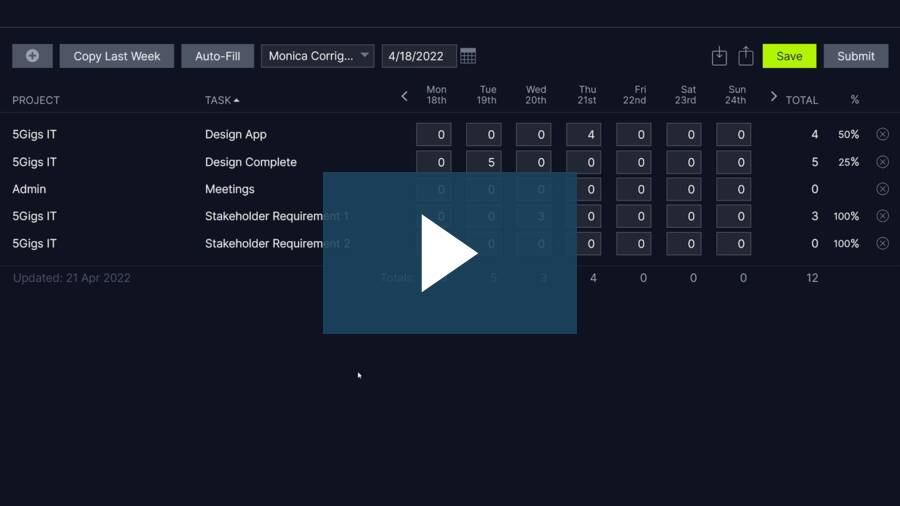
In fact, nearly every aspect associated with time management in a project can be monitored and tracked with timesheet software. Beyond just collecting the time a team works on a task, software can keep track of scheduling, resources and other variables that are associated with a task's execution. Microsoft Project is one of the most commonly used project management software, but it has major drawbacks that make ProjectManager a better choice to manage timesheets.
Timesheet management is a key component to bringing a project to a successful conclusion. Project managers need to monitor the time in their projects accurately to reduce costs and stay on track. The better your timesheet software does this, the better it is for your project.
Traditional Timesheets vs. Online Timesheet Software
Timesheets keep track of team hours—that's a necessity—but is it worth investing in an online timesheet software, or could a classic time tracking spreadsheet suffice? Certainly, smaller organizations that don't have to keep track of dozens of employees might only need to use printable timesheets, or just time log sheets and time cards. But once an organization scales up, so too does the complexities of ensuring proper payment to their employees.
Customizable
One advantage of an online timesheet compared to the old-fashioned way of logging hours with time log sheets and time cards is that you can customize them to fit the structure of your business. Not all companies are the same—they work in different sectors and have different needs when processing payroll. Online timesheets have the flexibility these businesses need to get their timesheets tracking more accurately.
Reporting
The problem with printable timesheet templates or even electronic timesheets made on Excel or Google Sheets is that they're data islands. While they're functional they don't go beyond the basic needs of a timesheet. On the contrary, an online timesheet has a central repository that can then be tapped to generate reports that give managers insight into how their teams are working and information to track the time in projects.
Security
Having an online timesheet software means that it can be electronically locked, keeping anyone from changing the information held within. Once a manager approves the employee timesheet, they can secure it to make sure that what arrives at payroll is the same as what they saw. No one can come in and fudge the numbers.
Easy Access
Printable timesheets have to be physically distributed, and even digital copies must be sent electronically. However, an online timesheet software is accessible anywhere and at any time. If you're managing teams who work in different locations and time zones, they can log into their timesheet when they need to update it without requiring you to send it to them.
This doesn't even speak to having timesheets that are integrated with a larger project management software and can update automatically as teams submit their status. While not being completely dismissive of the classic timesheets of yesterday, the online timesheets of today are what the workforce of tomorrow needs.
Must-Have Timesheet Software Features
The following timesheet software features are crucial, and should be kept in mind as you compare and contrast different offerings to make your choice.
Make Data-Driven Decisions
Accurate monitoring requires accurate time tracking. Online timesheet software that automatically updates in real time gives users a current picture of the work hours their team is logging. Better data drives successful projects.
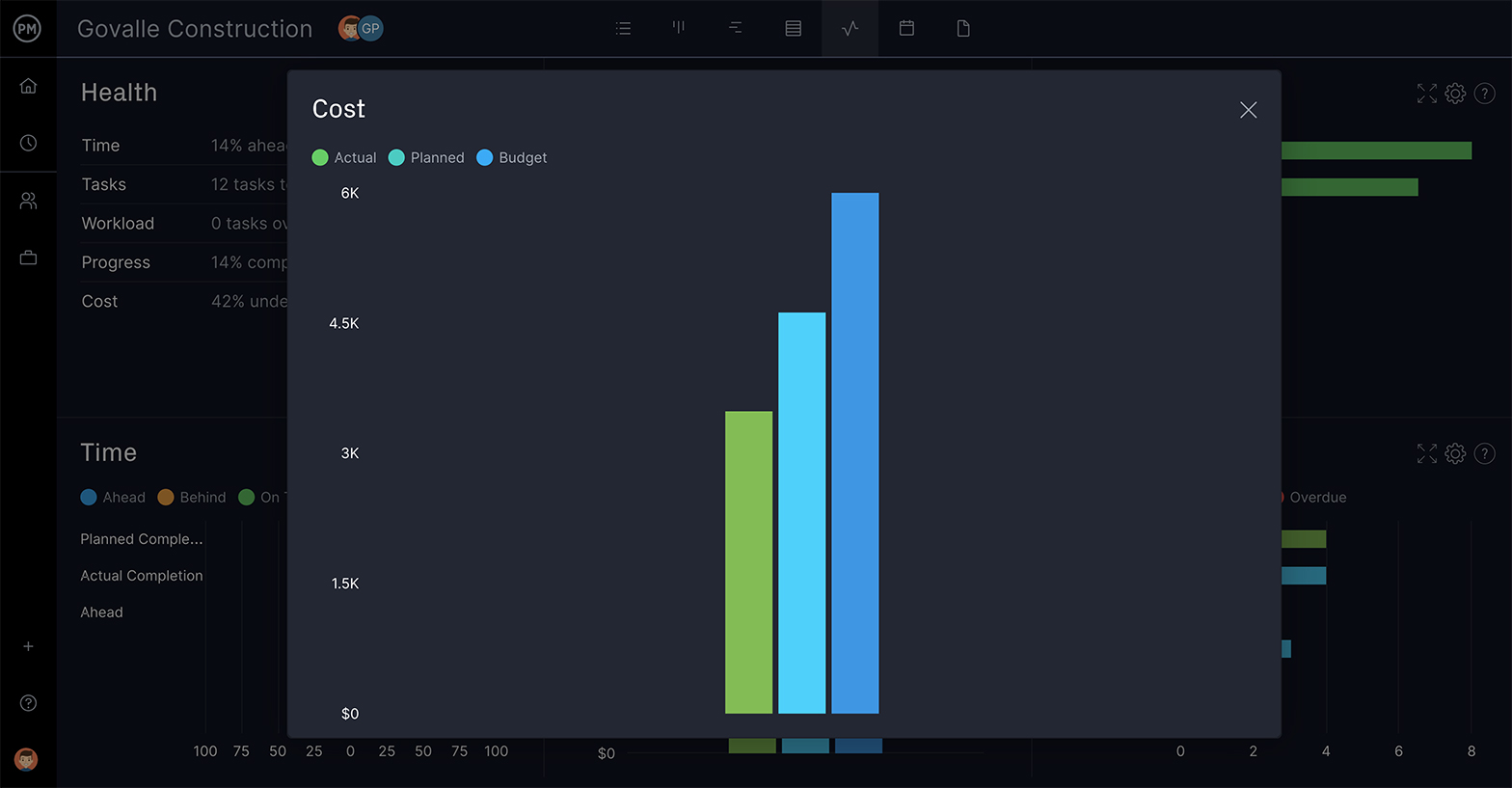
Submit Secure Timesheets
Keeping timesheets protected and making sure that they can't be tampered gives teams and managers confidence in the payroll process. Look for timesheets that can authorize a person to approve them, and once approved, locks the document to insure its integrity.
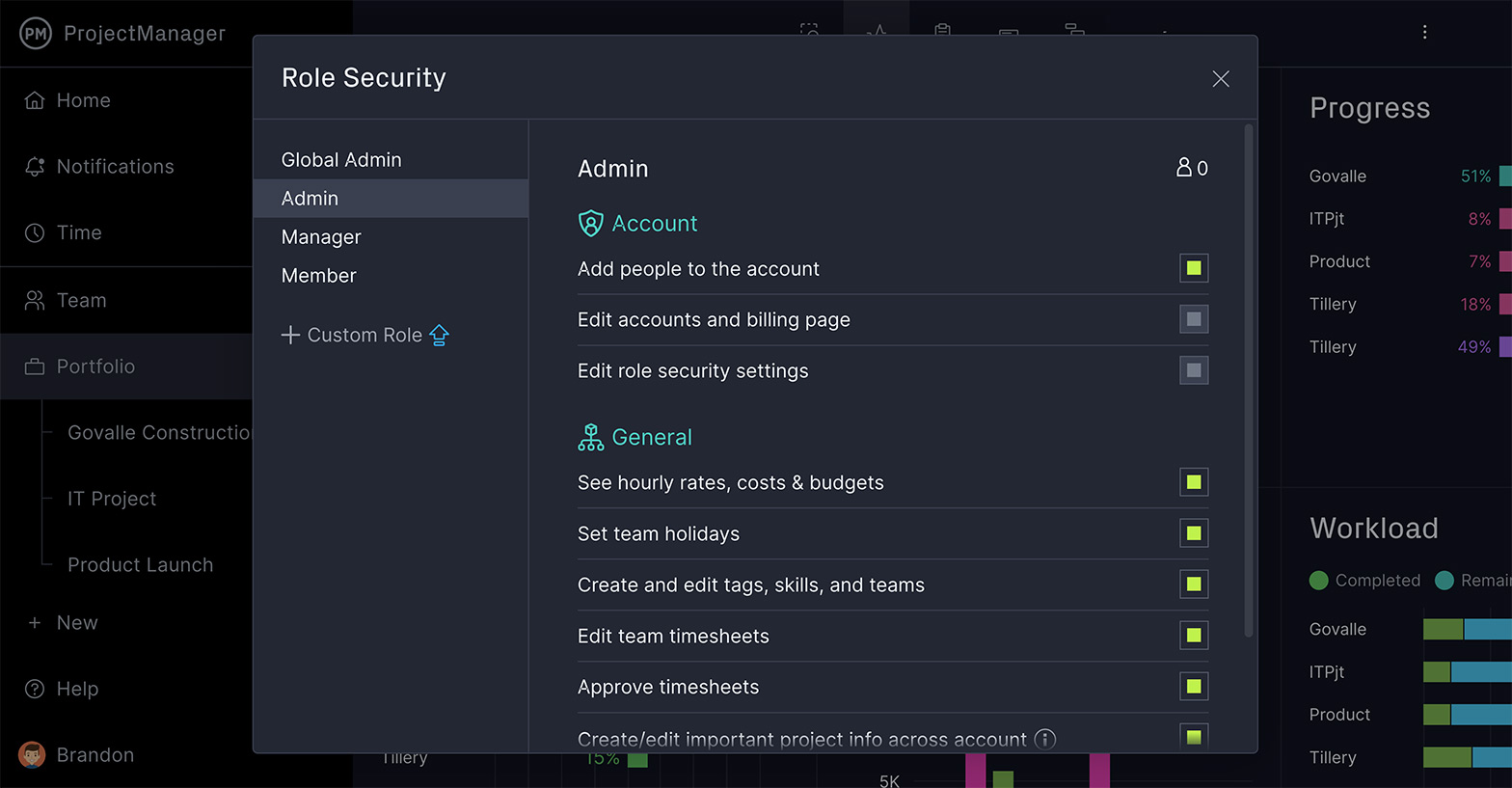
Automation Improves Efficiency
Features that streamline the timesheet process save time. Timesheets should have an auto-fill option to populate the timesheet with recurring tasks that have been assigned to a team member. When tasks are repeated, they should be easy to copy to the next timesheet.
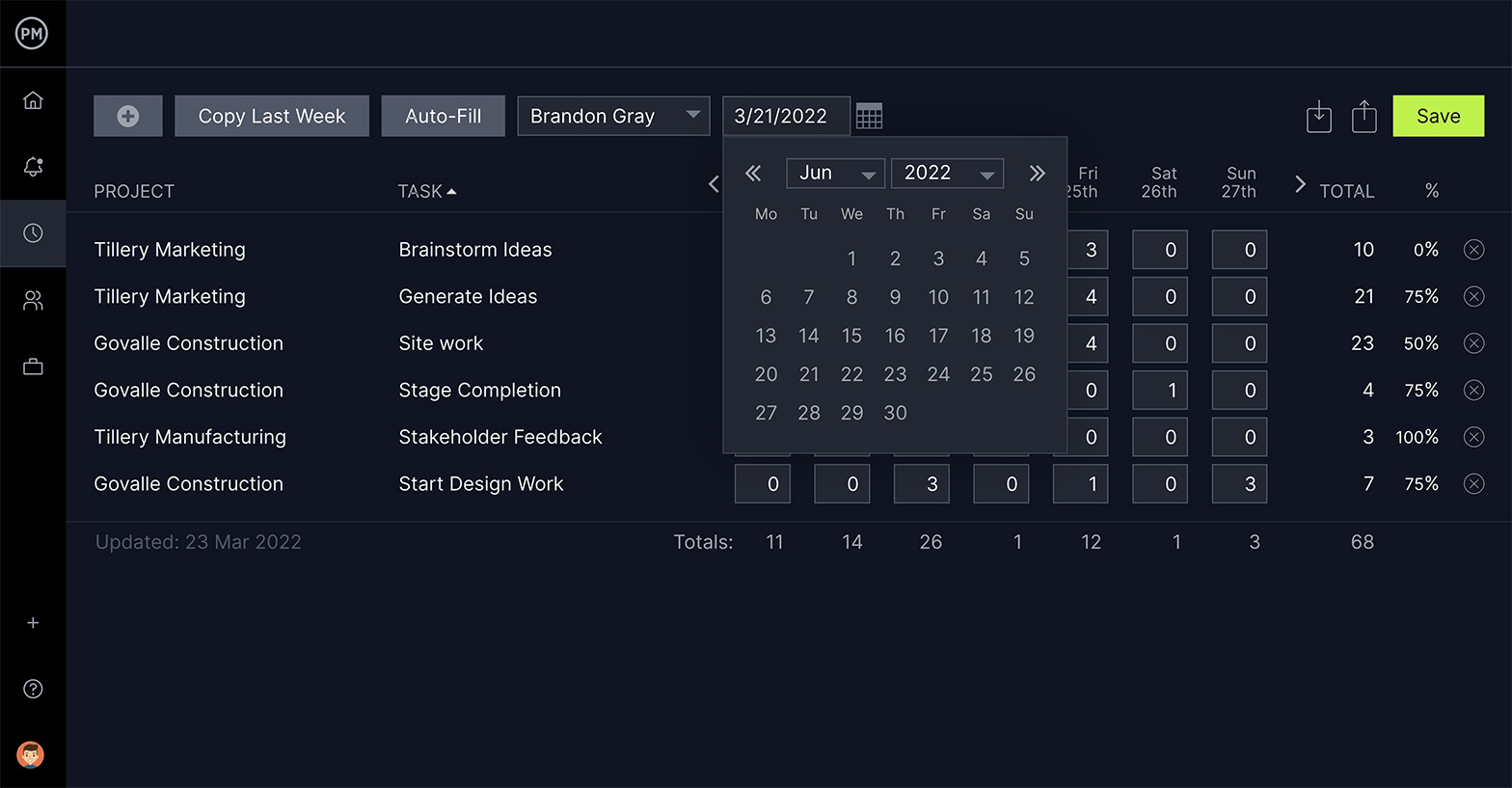
Share Timesheets With a Click
It's important to have a simple way to get your timesheet where it needs to go—whether you need to export it as a PDF and email it or print a paper version. Ideally, you want a tool that can export it to your manager, who in turn shares it with payroll.
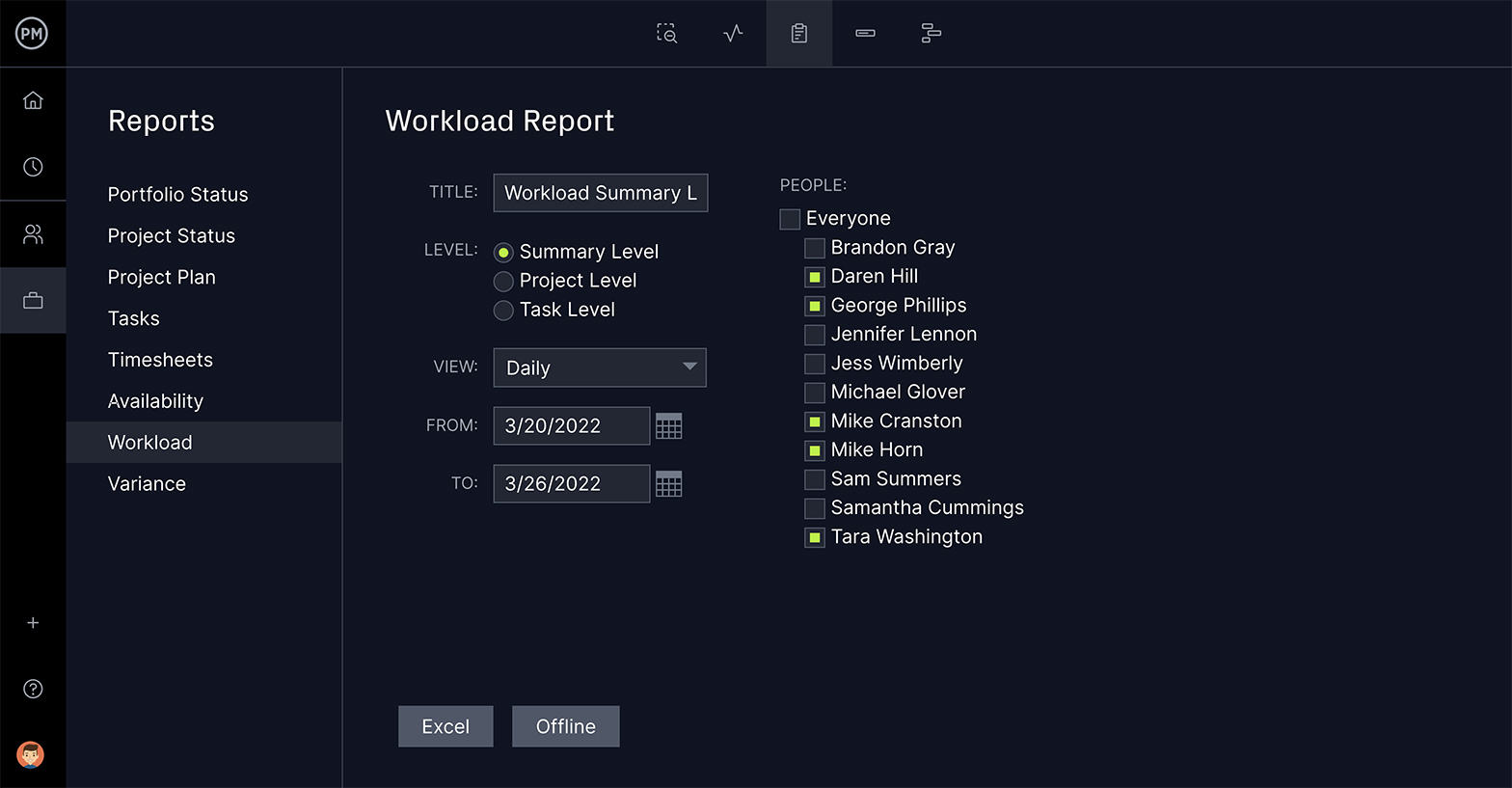
Get Deep Project Insights
Timesheets are a potential well of information, if used properly. You want to tap into all that data with reports that can be filtered to show what you want to see, and then shared with stakeholders to keep them updated on progress.
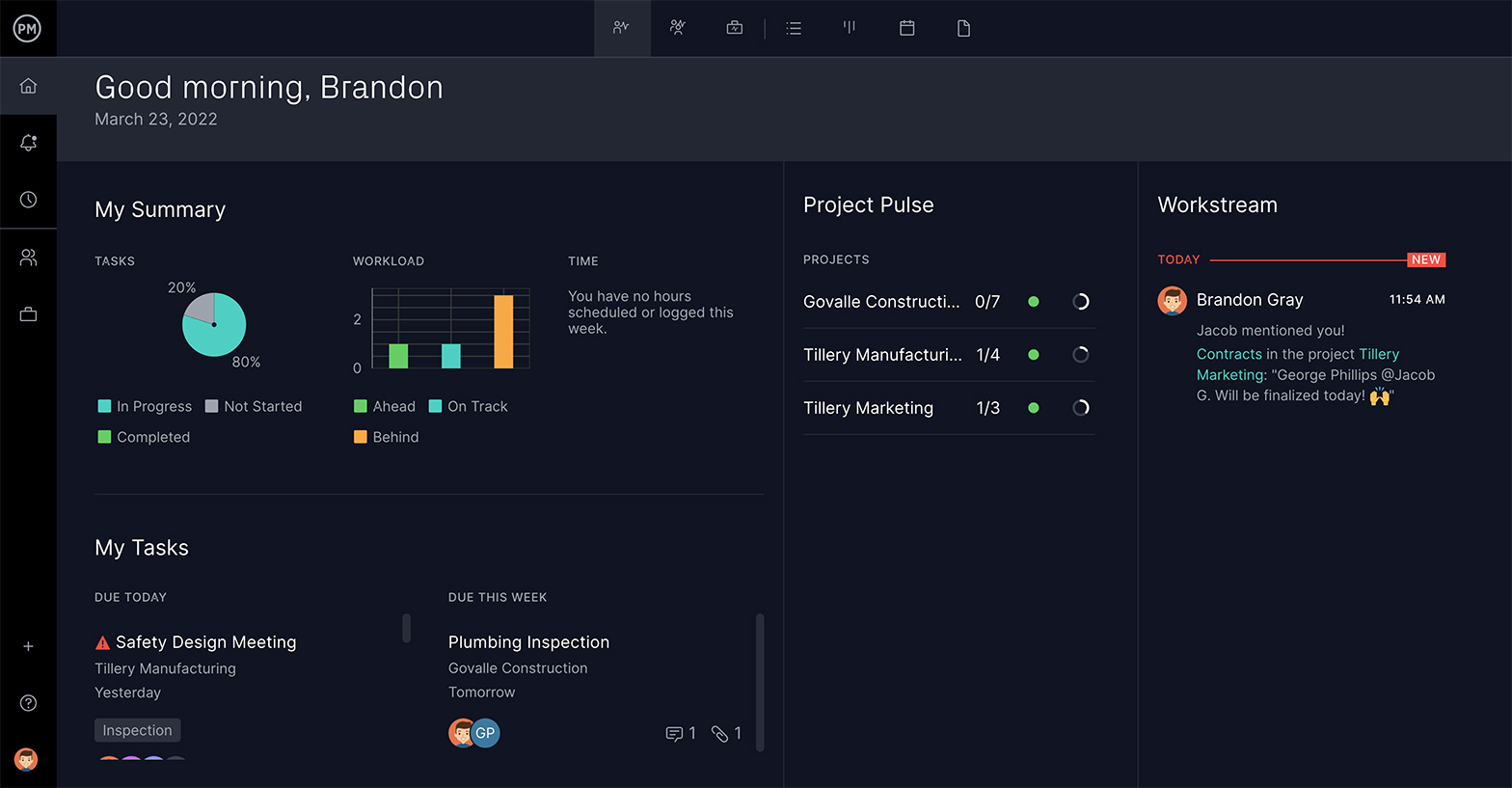
Add Files and Comments to Timesheets
The ability to attach files and comments to your timesheets is important. If, for example, your team submits a timesheet with more hours than expected, they can attach a file of their deliverable to justify the extra hours. A timesheet should have unlimited file storage to do this.
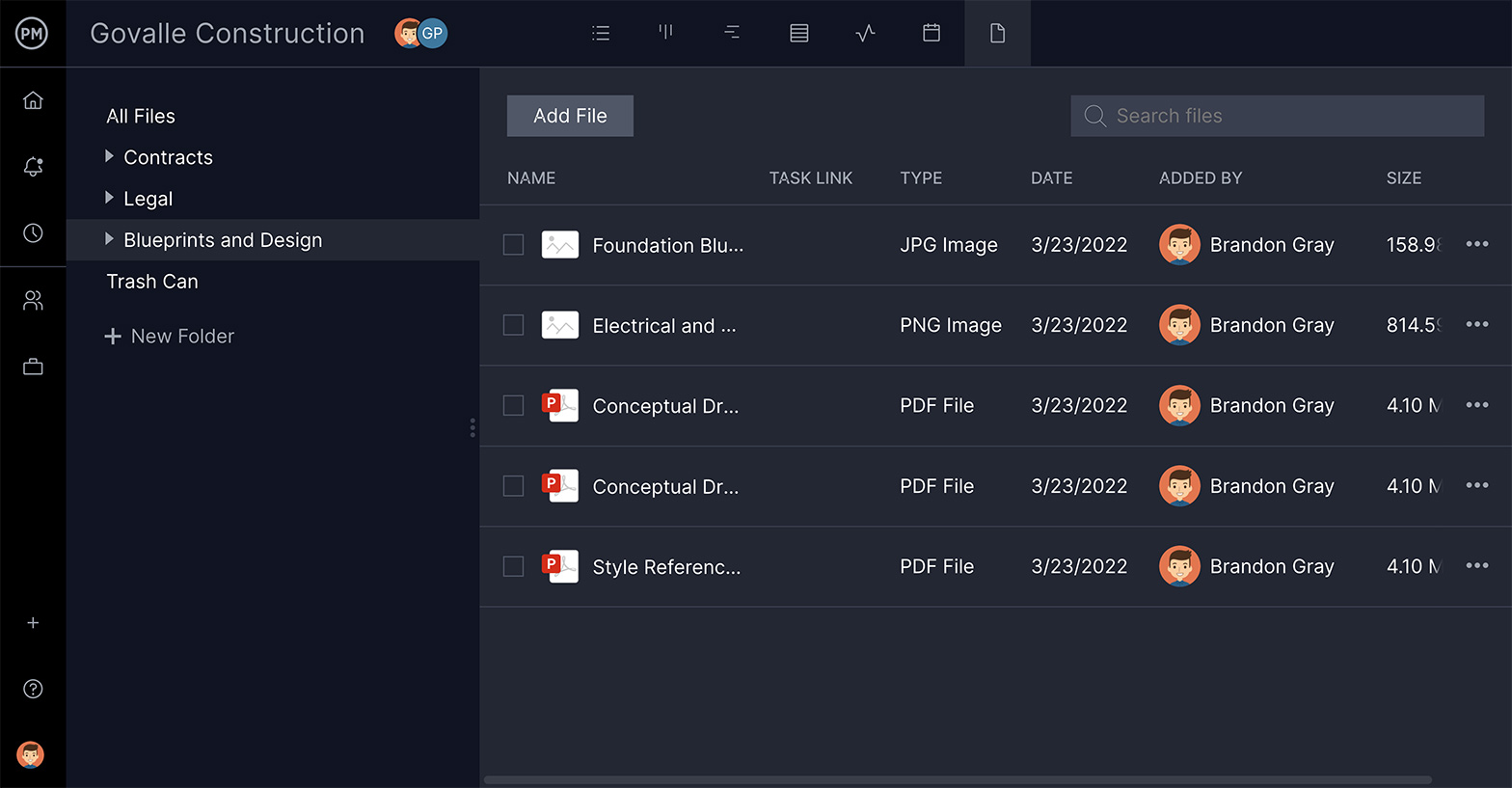
Timesheet Template
To get acquainted with a typical timesheet, we've created a free timesheet template for newcomers to play with and explore on your own. It's a typical, weekly timesheet example that includes hourly rate total hours, regular hours, overtime hours and vacation considerations.
If you decide to eventually use ProjectManager, the above Excel template can be directly imported for you to continue your work.

Related: Free Project Management Templates
How Do You Complete a Timesheet?
The easiest timesheets to complete are those that link automatically to your project schedule. You'll save a lot of time on entering the task data if all you have to do is pick the tasks from a list. Whether it's automatically integrated, and therefore pre-populated, or not—you'll need a list of tasks on your timesheet before you can complete it.
Best Practices for Online Timesheet Software
Timesheet software is a key component in tracking time spent on tasks and projects to make sure you stay on schedule. Timesheets are also important in terms of expense tracking to help you monitor the costs of your project.
ProjectManager has an integrated timesheet feature that works together with all the tools on our software to make using timesheets easier, while giving you greater transparency into your project's progress. Here's a quick walk-through on how to use timesheets on our software. Sign up for a free trial and follow along to get your projects moving smoother than ever.
1. Create Your Project
Timesheets are much easier to manage when you have an idea what tasks employees will be working on ahead of time.We recommend you begin with laying out the tasks that you'll need to reach your final deliverable.
You can create a blank project to start with in the software, or you can use one of our industry-specific templates to get started.

2. Invite Your Team
Assemble your team. Choose members who have the experience and skillset to tackle all the tasks required to get the job done.
In the software, invite team members to the project. They will be notified by email that they have been added.
3. Add and Assign Tasks
Tasks are the building blocks of your project, and thoroughly planned out task lists direct your team throughout the entirety of the project. Therefore, practicing proper task management, with clear direction and other details, is essential.
Assign tasks to team members and add labor costs. Add the estimated hours for each task for team members to know what's expected of them. Once the hourly rate and hours are logged, you can monitor your budget.

4. Designate a Timesheet Approver
Assign someone from the team who will receive the submitted timesheets. This person (usually a manager) will make sure that the billable hours match the tasks completed.
Under the Manage Users tab, choose an approver who the team member will submit their timesheet to for review. This person will be the gatekeeper between the team member and payroll/Human Resources.
5. Have Team Members Log Their Hours
Each team member is responsible for tracking the hours they work on a task. This information is then collected on the timesheet.
Log hours on individual tasks, or log them on the timesheet. You can also click auto-fill to pull in all the tasks assigned to you.

6. Review the Timesheet
Much of the timesheet process in ProjectManager is automated to save time and increase efficiency. However, there still needs to be a person who looks over the timesheet to make sure it's correct before passing it on to payroll.
After the requisite amount of time has passed (typically weekly, bi-weekly, monthly, or bi-monthly), it's time to review the timesheet before submission. View the timesheet by clicking time on the primary navigation menu. Set the week you want to review.

7. Submit the Timesheet
Submitting the timesheet to the approver on the team who approves them is the next step of the process.
In order to ensure you submit your timesheets in a timely fashion, you can set up alerts that can be set up at a certain day/time every week. You will be reminded by email.
8. Approve Timesheet
The approver will receive the employee timesheet and must look over the hours and tasks to make sure there are no mistakes. If there are discrepancies, then the timesheet needs to go back to the person who submitted it.
If the approver rejects the timesheet, the submitter will be notified. There will be a field in which you can explain any discrepancies and can resubmit. Once approved, the timesheet is locked. As shown in the timesheet example below, approving or rejecting the timesheet is very simple with ProjectManager.
9. Make Reports
Now that your timesheet is approved, you can take your time tracking even further by using reports. Reporting is useful to go over all of your data and identify bottlenecks, overages and other discrepancies.They are also an essential tool for keeping stakeholders in the loop.
You can make reports from timesheet data for individual users, or projects over a specific date range to get more detailed information on progress. Customize and share reports as a PDF or spreadsheet for when you have a stakeholder presentation.

ProjectManager is a trusted, award-winning software that has helped project managers complete over 2 million projects. Access to our robust timesheet management tools can be just what you need to unlock the next level of productivity.
Start making your timesheets now, with a free 30-day trial to ProjectManager!
The Many Uses for Timesheets
We touched on this earlier, and now we'll take a deeper dive into the benefits of timesheets beyond just tracking time and paying employees.
To build a database of historical information.
The data output from time tracking comes in the form of timesheets that show how long an individual spent doing a particular task. This is valuable data, because many of those tasks will happen again in the future. Your time tracking data repository will let you estimate better in the future because you can draw from real-life data.
For example, let's say you estimate that preparing the wireframes for a new website will take 5 days. You put that on the project schedule and it automatically feeds through to the timesheets for the relevant resources. They complete the timesheets with the actual work hours spent on doing the wireframes. The wireframes take two people 4 days, so that's 8 days of effort in total.
The next time you come to estimate the task for creating wireframes, you can use the real data of 8 days and create a far more accurate project schedule.
For billing clients
This one is pretty obvious. As we explained at the start, if your commercial model relies on charging clients for your time, then you need to know how much time to charge them for. Timesheets also give you the detail so you can spell out exactly what you did on a project.
This is helpful if ever your invoices are queried, and especially when work takes longer than planned because of changes the client requested. Weekly timesheets are the standard to keep clients informed. However, daily timesheets can be more effective in projects with a shorter duration.
To manage your workload
Managers and employees are often surprised when they start to track their time, because they can see exactly where they are spending the most effort. And it isn't always where it should be.
Timesheets can be really helpful in pointing out why you aren't as efficient as you think you should be because they flag up where your time is going. This helps you manage your workload more efficiently, both during a single day and also over a longer period of time like a week.
How Often Should You Fill Out A Weekly Timesheet?
There is no hard and fast rule about this, but generally it's better to complete each day on your weekly timesheet as soon as you can so you remember what you spent your work time on.
If you don't have that many tasks, it's likely you can manage your weekly timesheet by completing them once a week. If you have a lot of separate tasks to do in a day, though, then it's better to spend a few minutes recording your time just before you log off for the day.
How To Manage Absences and Vacations on Timesheets
Sometimes you won't want to record time against project activity because a staff member is off sick or on annual leave. This might compromise the accuracy of your expense tracking.
The easiest way to manage this is to set up an 'admin' task called 'Sickness' or 'Vacation' and have them record their normal working hours against that instead. Depending on the company's policies, it can be considered paid time off or not, which should be specified on the online timesheet.
When a period of downtime affects everyone, such as closing the office for a holiday, you can change the working hours in the master calendar so that your team doesn't have to record time on those days.
Should You Keep Timesheets Confidential?
Timesheet management data shouldn't be kept confidential because, in theory, your team should know what you are working on and vice versa. There's really nothing sensitive in the high level task name for the vast majority of project scheduling information. If it has been scheduled, your team can see the scheduled task anyway. Employee time tracking also includes the manager.
Timesheets – Good or Evil?
Managers tend to fall into two camps when it comes to time tracking: they either understand the value of doing it and are huge supporters, or they don't see the point and believe it undermines trust in the team. If you fall into the second camp then, hopefully, this will explain why you should be reconsidering tracking time on your projects.
It's a truism that you can only manage what you measure. Successful project managers know how far through their project they are at any time. This information helps them establish whether they are ahead or over budget and whether they are likely to hit their upcoming deadlines. Monitoring time and costs is essential for the success of any project. While online timesheets are the best choice because of their feature set, electronic timesheets, or even printable timesheets should be used to track the progress of any project.
Unless you know how long a task has taken, and can compare that to how long it was scheduled to take, then understanding the performance of your project is much harder.
How to Overcome Resistance to Using Timesheets
One of the concerns that you may hear from managers is that the team will hate using timesheets. Because of this seemingly commonly held sentiment, it can be daunting to move to time recording when you haven't previously worked like that. Introducing employee time tracking where it isn't already in practice is a huge cultural change for many organizations.
If there is resistance in your organization, take a step back and ask why there is that level of opposition. It could be because
- They feel timesheets are a lot of work.
- They feel micromanaged.
- They feel that timesheets could be used to penalize staff who don't log enough hours.
The best way to deal with these concerns is to sit with the team and explain what you are doing to address them. For example, if they are worried that completing their timesheets will be a hassle, show them how easy it is to click and submit using online time tracking software.
When you know why team members are resistant to tracking their time you can manage their concerns individually. You might need to develop strategies with human resources to get your team on board.
How to Save Your Team's Time When Using Timesheet Trackers
Time tracking in itself is an additional task to do. However, it doesn't have to be onerous. Time tracking software makes this process quick, efficient and easy for everyone involved.
If you regularly complete the same tasks for the same projects, you can use the common "Copy Last Week" feature to auto-populate your timesheet for this week. Either hit save straightaway, or make a few tweaks and submit it.

You can even save time when you're creating a bespoke weekly timesheet. If your time tracking software links to your project schedule, you can "Auto-Fill" to pull through the tasks that you have been assigned, saving you the job of typing them out. The added benefit here is that they'll automatically feed your time data back to the project schedule, which updates the task to show how much effort has been spent on it to date.
Next Steps for Time Tracking
The easiest way to see if time tracking will be of benefit to you and your organization is to simply commit and start recording your time on tasks. The hardest aspect of keeping time is maintaining the habit.
When applied properly, project timesheets will quickly become the norm for your team, and completing them will be another aspect of collectively achieving success. Soon, you'll wonder how you ever managed to run your projects without the rich data that time tracking will provide.
It won't be long before your estimates improve, your confidence in hitting deadlines is bolstered and your project success rates increase.
Now that you know everything you need about timesheets and tracking time, it's time to get started! Sign up for your free 30-day trial of ProjectManager and start tracking time on your tasks today.
Start Your Free 30-Day Trial
maldonadocovid1986.blogspot.com
Source: https://www.projectmanager.com/guides/timesheets
0 Response to "How to Make Timesheets Easy for Employees"
Post a Comment